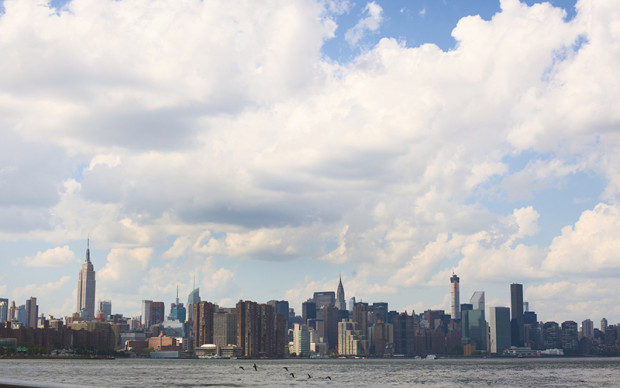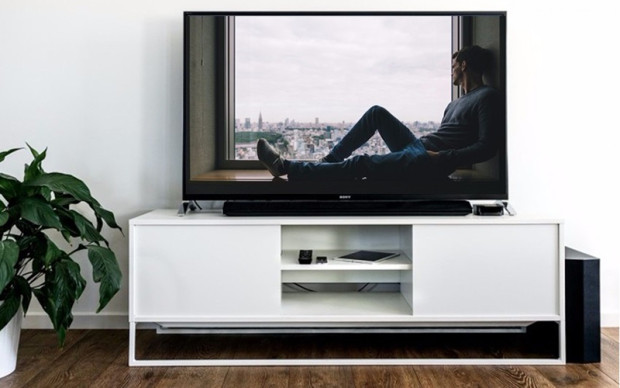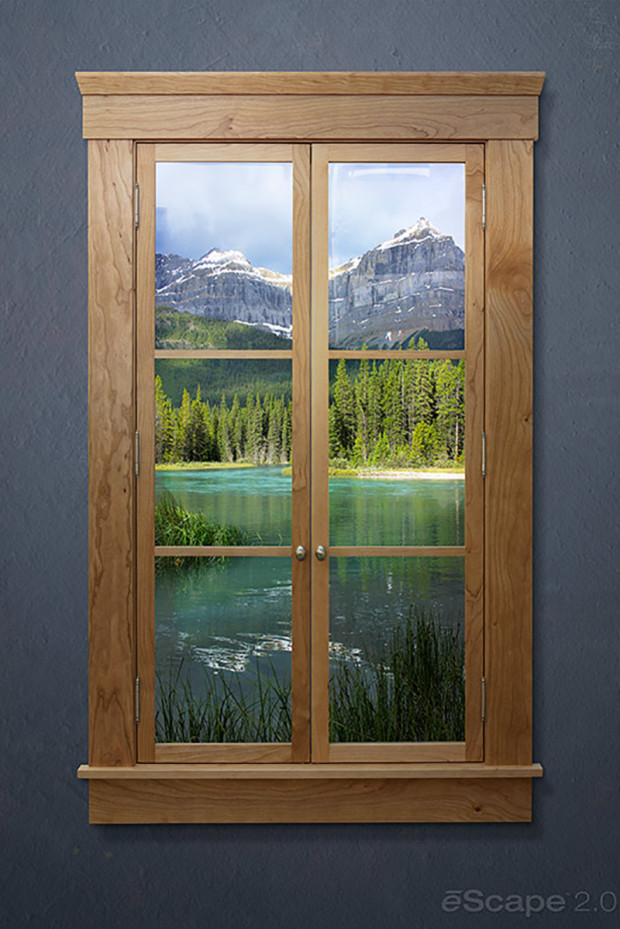This article is a collaboration between Bill Witherspoon, founder, Skye Witherspoon, CEO, and myself in my role as Director of Research Initiatives at The Sky Factory. It was inspired by Bill Browning’s Real vs. Simulated Nature section in The Global Impact of Biophilic Design in the Workplace report, and its timely review to how past studies have sought to simulate a window with a view to nature.
It is no secret that the most sought-after feature in any architecture is a visual connection to nature. The reason is simple.
According to Terrapin Bright Green’s 14 Patterns of Biophilic Design, A Visual Connection to Nature has the most robust scientific evidence behind its abundant benefits for human wellness.
It reduces stress. It balances the emotions. It improves cognitive function.
What’s not to like?
The challenge though, has everything to do with demographics. According to Human Spaces’ own Global Report on Biophilic Design, metropolitan populations have been on a six decade growth pattern that shows no sign of abating.

Two-thirds of humanity will live in cities by 2050 placing a wellness premium on a visual connection to nature.
Cities continue to sprawl and spiral upward. Population density keeps rising, presenting a formidable challenge to architects, interior designers, and urban planners.
Where will a visual connection to nature come from in our multiplying steel, glass, and concrete jungles? Particularly when the high cost per square foot of construction conspire and press against the open, green and sky-blue spaces our physiology finds so restorative.
Until the very premise of the mega-city is questioned and urban planning aims to decentralize, most of us will likely face a deficit in our ability to access undisturbed nature within a reasonable radius of our residence and workplace.
What to do?
Interior Design: Real vs. Simulated Nature
Until now, academic research exploring real versus simulated nature environments has yielded common sense results: real visual access to nature provides the most therapeutic benefits.
Nature simulations offer less dramatic benefits, but represent an improvement over enclosed interiors without any visual connection to nature.
And while the purpose is not to substitute genuine experiences of nature, given the longevity of commercial buildings, incorporating nature simulations in our architecture remains the most practical and economic alternative.
With an average global life of 80 years, outmoded building design will be around for decades.
How can these spaces, many of which include millions of square meters of enclosed interiors, be retrofitted to provide a measure of biophilic respite to current and future occupants?
One thing is certain. Simulated nature design must move away from its reliance on representational imagery and high resolution video feed systems and explore a more powerful image typology—multisensory imagery as biophilic illusions—that are better suited to deliver the deeper restorative benefits for which real views to nature are revered.
At the same time, we must take a closer look at what earlier real versus simulated nature studies reveal about our cognitive perception presumptions.
Context Alters the Beholder’s Experience
Vision is the most dominant of our five senses. It is responsible for two-thirds of the entire electrical activity in the brain. That’s a full 2 billion out of the 3 billion firings per second.
But how we see and make sense of our environment is part of a more complex neurological puzzle that our brain assembles from a host of sensory cues.
How our cognitive perception locates our sense of self in a shifting environmental map is a fascinating story of sensory integration, neural interpretation, and outright cognitive chutzpah (some might prefer the less sensational evolutionary).
Given the proper environmental cues, our brain literally makes space.
This is the world of multisensory stimuli where the magic of optical illusions takes place.
Although optical illusions have a place in the history of architecture, as well as in the visual and the performing arts, research into the power of illusions—and their ability to maintain our organs of perception beholden to an experience wholly at odds with “reality”—has not been taken advantage of by evidence-based or environmental design researchers.
Research in environmental psychology and workplace design could very well avail itself of the rich phenomena inherent in biophilic illusions of nature to explore human outcomes, fine tune comparative methodologies, and bridge the real-versus-simulated-nature experimental gap.
Most studies looking into the effects of simulated nature have taken a rudimentary approach. They have introduced the obvious: flat screen monitors with a streaming video feed from a camera positioned to capture a surrogate view outside the building. In other words, replicating an actual view is what is understood as a bona fide simulation.
One could simply call this a photo-realistic interpretation of the world.

Photo-realistic depictions lose essential spatial cues when visual content is devoid of environmental context.
And while this approach appears reasonable, the fact is that this approach fails to understand what makes a room with a view to nature, convincingly real.
After all, if a literal interpretation of reality was required to evoke a cathartic experience, the arts would not galvanize the emotions or vividly transmit experience. In fact, the world of design is awash in examples that forgo literal replication of reality in favor of extrapolations of it. As long as such efforts weave the proper cues tying design into that collective reservoir of human experience, extrapolations of reality are able to convey genuine experience.
In the case of simulated views to nature, replicating a real one with a video feed is akin to missing the forest for the trees. The trick is not in replicating content, but in staging it within the proper environmental or architectural setting. Only then do we engage and set our hardwired habits of perception on an inexorable path of interpretation.
One that yields a credible illusion of nature. A room with a view.
It is not what we see, but how we perceive visual content within a specific context of sensory stimuli that reveals how cognitive perception operates. It is this understanding that needs to better inform research design in areas concerned with wellness, health and human productivity.
Let’s take the University of Washington’s study cited by Bill Browning where participants subjected to a stressful experience were given one of three different recovery period conditions. These were: 1) sitting at a desk facing a wall of grey curtains, or 2) facing a wall with grey curtains with one segment open to a window showing a view to a water feature and trees, or 3) facing a wall with grey curtains with one segment open to a high-definition flat-screen television, equal to the window dimensions, showing real-time video of the actual view.
However, the research team make a key presumption. They assumed that replicating the window view on a monitor—a device in the room rather than a feature of the interior envelope—accounted for all the environmental elements that our organs of perception process to gain the restorative benefits of a view to a natural exterior.
This is far from the case.
Visual stimuli devoid of context, in this case architectural context, becomes symbolic, abstract, untethered to a sense of place. When imagery loses its spatial anchor to the environment, the restorative benefits of the simulated window for the observer lose their immediacy.
What started out as vivid, multisensory content in the window scenario becomes flat, one dimensional content in the window simulation. For the restorative benefits of the window to lose less sensory immediacy, it is essential to preserve their environmental context.
The Architectural Impact of Perceived Open Space
In the Environmental Design & Mechanics of Perception section of Sky Factory’s upcoming white paper, The Architectural Impact of Perceived Open Space, the authors note how neuroscience has uncovered many of the inferences our sensory processing makes from the outset, filling in the gaps from missing or misleading visual input. The paper also notes how our brain routinely makes assumptions about sensory input, confirming that our perception is born of a process of interpretation where environmental context plays a pivotal role.

A successful illusion of nature includes context to trigger depth perception. © 2016 Sky Factory
This phenomenon, according to neuroscientists Stephen L. Macknik and Susana Martinez Conde, authors of the fascinating book Sleights of Mind, is an unavoidable result born of the “sheer limitations in the numbers of neurons and neural connections underlying our sensory and mental processes.”
We are accustomed to the notion that our perception of reality of what is “out there” is accurate, but this simply is not true. Our visual circuits are not passive transmitters of sensory input, but actively “amplify, suppress, converge, and diverge all incoming visual information,” to use Macknik and Martinez-Conde’s own words.
This evidence underscores the relevance of architectural context in simulated nature design.
2 responses to “Simulated Nature Research Gets Real, Part I”
Please keep thnwiorg these posts up they help tons.
[…] nature into the middle of a large building? One idea is to use artificial windows, as mentioned in this 2016 blog post. There is some merit from mounting a videowall and displaying natural content. We humans like […]